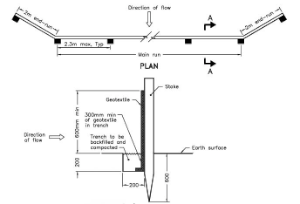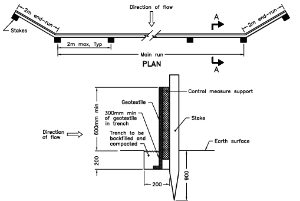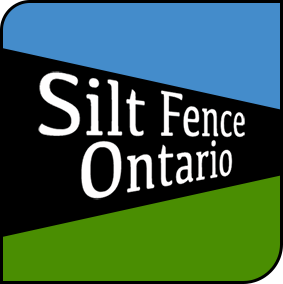Whether it's following an engineer's drawings or designing a site specific fence installation, proper fence design requires an understanding of soil composition and potential water flow.
Common fence upgrade options include:
- Construction / Snow fence backing
- Wire backing - this can be added to support the silt fence, if perceived heavy loading could occur or if installed in sensitive areas where failure is not an option.
- T-Post instead of wood posts - T-posts can be driven into rockier soils where wooden posts can not. They will not break like wood posts but they do have sharper edges which could damage the silt fencing.
- Closer spacing of posts - this may add an initial cost but will reduce repetitive maintenance, if more than expected water/soil flow occurs .
At minimum, our silt fences meet the Ontario standard OPSS 805 and OPPSS 1860 (Table 3) for tensile strength, typical elongation at break, permittivity, filtration opening size and minimum ultraviolet stability.
Common fence upgrade options include:
- Construction / Snow fence backing
- Wire backing - this can be added to support the silt fence, if perceived heavy loading could occur or if installed in sensitive areas where failure is not an option.
- T-Post instead of wood posts - T-posts can be driven into rockier soils where wooden posts can not. They will not break like wood posts but they do have sharper edges which could damage the silt fencing.
- Closer spacing of posts - this may add an initial cost but will reduce repetitive maintenance, if more than expected water/soil flow occurs .
At minimum, our silt fences meet the Ontario standard OPSS 805 and OPPSS 1860 (Table 3) for tensile strength, typical elongation at break, permittivity, filtration opening size and minimum ultraviolet stability.
Light duty silt fence to OPSD 219.110 (1.2m stakes or posts required)

Heavy duty silt fence to OPSD 219.130 (1.5m stakes or posts required)

